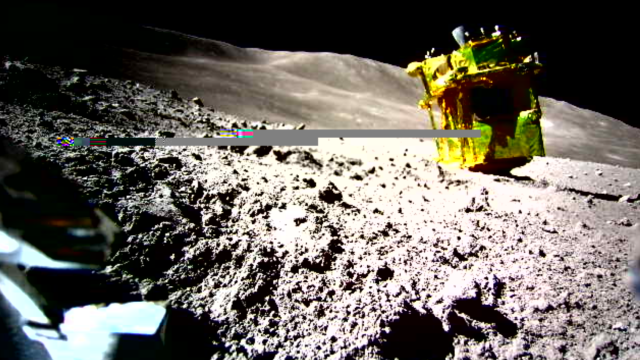The saga of Japan’s lunar lander continues to unfold, with the first images of SLIM on the surface of the Moon revealing the unfortunate position the spacecraft has ended up in.
Nearly a week after the SLIM lander touched down on the Moon, the Japan Aerospace Exploration Agency (JAXA) released an image of its spacecraft taken by a tiny rover called Sora-Q, which arrived on the Moon with SLIM. The image shows SLIM in a bind, with its thrusters pointed upward and, worst of all, its solar arrays facing west, away from the Sun.
“Due to the spacecraft not being at the planned attitude upon landing, power generation was not possible from the solar cells, and the spacecraft was shutdown with a command from the ground,” JAXA wrote in a statement.
SLIM (Smart Lander for Investigating Moon) achieved a historic landing on the Moon on Friday, January 19, making Japan the fifth country to successfully put a spacecraft onto the dusty lunar surface. Shortly after, however, JAXA reported that SLIM’s solar cells were not generating enough electricity. The space agency made the decision to shut down the spacecraft’s system around three hours after landing to conserve its remaining power, which was at 12%.
JAXA did manage to gather some data before SLIM was shut down, which confirmed that the spacecraft was within 55 metres of the target landing site. That means the space agency achieved the primary goal of the mission, testing cutting-edge precision technologies to ace a pinpoint landing.
Unfortunately, one of SLIM’s two main thrusters likely failed during the final landing phase. The lander was supposed to first land with its thrusters facing down toward the lunar surface; then, a small thruster burn was meant to tip SLIM over on its side. With the spacecraft facing an anomaly, it ended up with its solar arrays facing the wrong way and unable to generate power from the Sun.
“The cause of the loss of the main engine functionality is now being investigated, including consideration of external factors aside from the engine itself, with the plan to determine the detailed cause,” JAXA wrote. “We will provide further information as the investigation progresses.”
The space agency is still hoping some sunlight could revive its spacecraft. The mission landed at the start of the lunar day, when the Sun rises in the east and provides around two weeks of light. Toward the lunar afternoon, the Sun will start to move more toward the west. “So if sunlight begins to shine on the lunar surface from the west, there is a possibility of generating power, and we are preparing for recovery,” JAXA explained on X.
